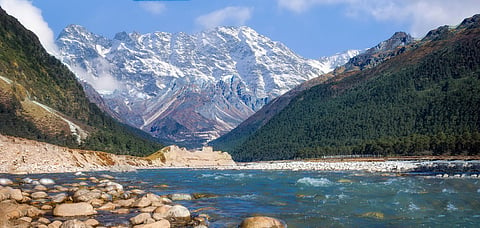
- Destinations
- Experiences
- Stay
- What's new
- Editor’s Picks
- Responsible Tourism
- CampaignsCampaigns
- Subscribe

The eastern Himalayan foothills, lying on the north-eastern part of West Bengal in India, has been long considered a gateway to the neighbouring country of Bhutan. Probably that was why it got the name of Dooars, a corrupted form of the Bengali word &lsquoduaar&rsquo meaning door. Whatever may be the reason for the name, the region &ndash located a few hours&rsquo drive away from the region&rsquos transport hubs, New Jalpaiguri and Siliguri &ndash is a nature lovers&rsquo delight.
No sooner than you clear the urban sprawl, the road begins to meander through lightly wooded forests and lush tea gardens. A little later, as you turn away from the busy road going uphill towards Darjeeling and Sikkim, and cross the Teesta River, the traffic thins out. The tea gardens and forests come closer. The crisp cool air freshens the mind and helps you slow down for the laidback world that is waiting to be discovered.
There are several national parks and wildlife sanctuaries here that are home to the endangered Indian one-horned rhinoceros, the Indian elephant, Gaur, plenty of birds and other animals. To make the most of your holiday, chalk up an itinerary weaving in some of the wildlife reserves. You can also add a stay among the tea gardens for more variety.
Jaldapara National Park, said to be home to the second largest population of Indian rhinos (next to Assam&rsquos Kaziranga National Park), is the most popular wildlife reserve here. Lying within easy reach of this national park is Gorumara National Park and the Chapramari Wildlife Sanctuary.
Drained by the Torsa River and several rivulets, Jaldapara National Park includes moist deciduous forest interspersed with vast tracts of grasslands. Madarihat is the nearest entry point. The forest office, located near the state tourism&rsquos Jaldapara Tourist Bungalow, issues entry permits. A narrow road through the jungle leads to the Hollong Forest Bungalow located on the bank of the eponymous river. There is a salt lick near the bungalow and if you are lucky, you may see the animals, including deer, elephants and rhinos, visiting it. Otherwise, take a regular elephant ride or a jeep safari into the forest to see the animals. There are watchtowers inside the forest. With high demand for animal safaris, booking well in advance is recommended. It is necessary to arrange for your own transport to visit the elephant ride point near the forest bungalow from all other lodges. You can also visit South Khairabari forest and Totopara (a village belonging to the indigenous Toto tribe). A visit to Jaldapara can be combined with a visit to Phuntsholling (permission required) in Bhutan near its border with India. According to media reports, West Bengal forest department is likely to start forest treks in the region from this year.
Located on the floodplains of the Raidak and Murti rivers, Gorumara National Park consists of largely tropical moist deciduous trees interspersed with grasslands. Apart from being a home to rhinos, elephants, and Gaur, the forest also shelters over 150 species of birds and other fauna. Visitors can go on jeep safaris inside the forest. There are several watchtowers inside the forest. Chukchuki Watch Tower at one end of the national park is popular with birding enthusiasts. Apart from resident birds, you may catch sight of migratory birds in winter. The Chandrachud and Jatraprasad watch towers have been named after two of the department&rsquos most dependable elephants who have passed away. The Jatraprasad watch tower draws a lot of visitors and can be quite crowded at times. This watchtower offers a panoramic view of the landscape. Off the beaten trails is the Medla watch tower near the Kalipur Eco Village. Lataguri, located on the fringe of the forest, has plenty of private resorts.
The Murti River separates the least known of the three forests, Chapramari Wildlife Sanctuary, from its more famous neighbour Gorumara. With fewer visitors, the sanctuary remains tranquil for the greater part of the year except during the peak holiday season in winter when the local people gather at the river bank for picnic. Many visitors pay a day visit to Chapramari from Gorumara.
Overlooked by the mountains, hemmed by Gorumara and Chapramari forests, Chalsa is known for its tea gardens. Enjoy the scenic countryside. Go for long walks among the tea gardens. The Sinclairs Resort, located at Chalsa Hill top is the best place to stay here.
Getting there Bagdogra is the nearest airport for visiting Jaldapara, Gorumara and Chapramari. The nearest rail station is Madarihat. But New Jalpaiguri is the most convenient railhead which is connected to the rest of the country. From Siliguri, a key transport hub, Jaldapara is nearly 130km by road, Gorumara is nearly 80km and Chapramari is 70km away.
